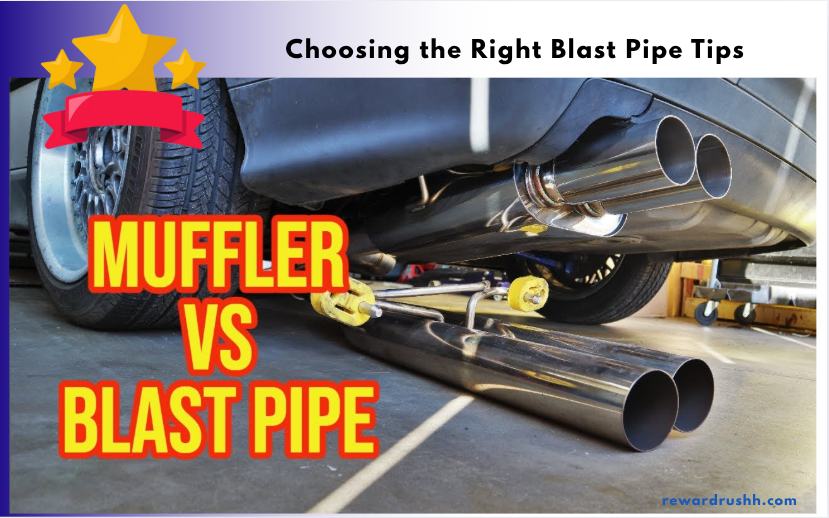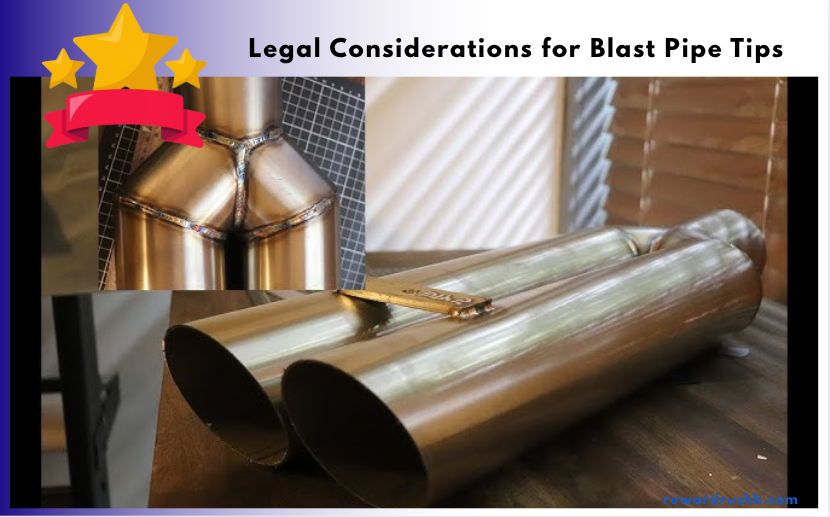Ever heard that roar of an engine and felt a shiver down your spine? That’s often the sound of a well-tuned exhaust system, and the blast pipe tips play a bigger role than you might think. Are you looking to boost your vehicle’s performance and give it an aggressive look? This article will cover everything you need to know about blast pipe tips for better exhaust performance. We’ll explore how they work, the benefits they offer, and how to choose the right ones for your ride.
Understanding Blast Pipe Tips
Blast pipe tips are more than just aesthetic additions to your exhaust system. They are designed to optimize exhaust flow and enhance the overall performance of your vehicle. Let’s dive into the specifics.
What are Blast Pipe Tips?
Blast pipe tips are exhaust extensions that typically feature a wider, flared design. These tips are usually made from stainless steel or other durable materials. They are welded onto the end of your exhaust system. Their primary function is to direct exhaust gases away from the vehicle. They also create a unique and aggressive sound profile.
How Do They Work?
The flared design of blast pipe tips helps to expand the exhaust gases as they exit the system. This expansion reduces backpressure. Reduced backpressure allows the engine to breathe more efficiently. This results in improved horsepower and torque. The design also influences the sound, creating a louder and more distinct exhaust note.
Benefits of Using Blast Pipe Tips
Adding blast pipe tips to your vehicle can offer numerous advantages. From performance gains to aesthetic enhancements, here’s a breakdown of the key benefits.
Enhanced Exhaust Flow
One of the primary benefits of blast pipe tips is their ability to improve exhaust flow. The wider opening allows exhaust gases to exit more freely. This minimizes backpressure and optimizes engine performance. Improved exhaust flow can lead to noticeable gains in horsepower and torque, especially in modified vehicles.
Improved Engine Performance
By reducing backpressure, blast pipe tips contribute to improved engine efficiency. The engine doesn’t have to work as hard to expel exhaust gases. This results in better fuel economy and increased power output. The enhanced airflow can also lead to a more responsive throttle and smoother acceleration.
Aggressive Sound Profile
Blast pipe tips are known for producing a distinct and aggressive exhaust note. The flared design amplifies the sound waves. This creates a louder, more pronounced roar. This sound enhancement is a major draw for car enthusiasts who want to make a statement with their vehicle.
Aesthetic Appeal
Beyond performance, blast pipe tips add a unique visual element to your vehicle. Their bold, flared design gives a sporty and aggressive look. They are available in various finishes. This allows you to customize the appearance of your exhaust system. A well-chosen set of blast pipe tips can significantly enhance your car’s overall style.
Choosing the Right Blast Pipe Tips

Selecting the right blast pipe tips for your vehicle involves considering several factors. These include size, material, and design. Making the right choice ensures optimal performance and aesthetics.
Size and Fitment
The size of the blast pipe tips should be compatible with your exhaust system. Measure the diameter of your existing exhaust pipes to ensure a proper fit. Consider the overall dimensions of the tips. Ensure they complement the vehicle’s design without looking out of place. Proper fitment is crucial for both performance and aesthetics.
Material Quality
Blast pipe tips are typically made from stainless steel, aluminum, or titanium. Stainless steel is a popular choice due to its durability and resistance to corrosion. Aluminum is lightweight. However, it may not be as durable as stainless steel. Titanium offers excellent strength and weight savings but is more expensive. Choose a material that balances cost, durability, and performance.
Design and Style
Blast pipe tips come in various designs, including single-wall, double-wall, and angled styles. Single-wall tips offer a simple, straightforward look. Double-wall tips provide added insulation and a more refined appearance. Angled tips can direct exhaust gases away from the vehicle. Consider the overall style of your vehicle and choose tips that complement its aesthetics.
Installation Tips for Blast Pipe Tips
Installing blast pipe tips can be a straightforward process. However, it’s important to follow some key steps to ensure a secure and effective installation.
Professional vs. DIY Installation
Decide whether you want to install the blast pipe tips yourself or hire a professional. DIY installation can save money. However, it requires some mechanical knowledge and the right tools. Professional installation ensures the job is done correctly. This can prevent potential issues down the road.
Step-by-Step Installation Guide
- Preparation: Gather all necessary tools, including a welder, cutting tools, and safety equipment.
- Removal: Remove the existing exhaust tips, if any. Cut the exhaust pipe to the desired length.
- Welding: Position the blast pipe tips onto the exhaust pipe. Weld them securely in place. Ensure the welds are strong and airtight.
- Finishing: Grind down any rough edges and apply a heat-resistant coating to protect the welds.
Safety Precautions
Always wear safety glasses and gloves when working with exhaust systems. Work in a well-ventilated area to avoid inhaling fumes. Use proper welding techniques to ensure a secure and safe installation. If you’re not comfortable with welding, it’s best to seek professional assistance.
Maintaining Your Blast Pipe Tips
Proper maintenance is essential to keep your blast pipe tips looking and performing their best. Regular cleaning and inspection can prolong their lifespan. This ensures they continue to enhance your vehicle’s performance and appearance.
Regular Cleaning
Clean your blast pipe tips regularly to remove dirt, grime, and exhaust residue. Use a mild soap and water solution. Apply it with a soft cloth or sponge. Avoid using abrasive cleaners. These can scratch the surface. Regular cleaning helps maintain their shine and prevents corrosion.
Inspection for Damage
Periodically inspect your blast pipe tips for signs of damage. Look for cracks, dents, or corrosion. Address any issues promptly to prevent further damage. Minor repairs can often be done yourself. More significant damage may require professional repair or replacement.
Preventing Corrosion
Corrosion can be a major issue, especially in areas with harsh weather conditions. Apply a protective coating to your blast pipe tips to prevent corrosion. Use a high-temperature paint or sealant designed for exhaust systems. Regular application of a protective coating can significantly extend the lifespan of your tips.
Blast Pipe Tips and Exhaust System Performance
The impact of blast pipe tips on overall exhaust system performance can be significant. Understanding how they interact with other components can help you optimize your vehicle’s performance.
Matching with Other Exhaust Components
Ensure that your blast pipe tips are compatible with other components of your exhaust system. This includes the headers, catalytic converter, and muffler. Mismatched components can lead to reduced performance and potential damage. Consult with a professional to ensure all components work together harmoniously.
Optimizing Backpressure
Backpressure is a crucial factor in exhaust system performance. Blast pipe tips are designed to reduce backpressure. However, too little backpressure can also be detrimental. Find the right balance to optimize engine performance. This may involve adjusting other components of the exhaust system.
Dyno Testing and Tuning
Consider dyno testing your vehicle after installing blast pipe tips. This will measure the actual performance gains. Dyno testing can identify any areas where further tuning is needed. Professional tuning can optimize the engine’s performance. This ensures you’re getting the most out of your exhaust system upgrades.
Legal Considerations for Blast Pipe Tips

Before installing blast pipe tips, it’s important to consider any legal restrictions or regulations in your area. Some areas have noise ordinances that limit the permissible sound levels of vehicles.
Noise Regulations
Check your local noise regulations to ensure that your blast pipe tips comply with the law. Excessive noise can result in fines or other penalties. Consider using mufflers or resonators to reduce the sound level if necessary.
Emissions Standards
Ensure that your blast pipe tips do not interfere with your vehicle’s emissions control system. Removing or modifying emissions components can be illegal and harmful to the environment. Consult with a professional to ensure your modifications comply with all applicable regulations.
Vehicle Inspections
Be aware that some vehicle inspections may include a check of the exhaust system. Non-compliant modifications can cause your vehicle to fail inspection. This prevents you from legally operating it on public roads. Ensure your blast pipe tips meet all requirements to pass inspection.
Conclusion
Blast pipe tips are a fantastic way to enhance your vehicle’s exhaust performance and give it a bold, aggressive look. By improving exhaust flow and reducing backpressure, they can boost horsepower and torque. Selecting the right tips and maintaining them properly will ensure you get the most out of your investment. Have you considered adding blast pipe tips to your ride? Share your experiences or ask any questions you might have in the comments below!
Frequently Asked Questions (FAQ)
1. Will blast pipe tips really improve my car’s performance?
Yes, blast pipe tips can improve your car’s performance by enhancing exhaust flow and reducing backpressure. This can lead to increased horsepower and torque. The extent of the improvement depends on your vehicle and the existing exhaust system.
2. Are blast pipe tips legal in all states?
No, blast pipe tips may not be legal in all states due to noise regulations and emissions standards. Check your local laws and regulations to ensure compliance. Consider using mufflers or resonators to reduce noise levels if necessary.
3. How do I choose the right size blast pipe tips for my car?
Measure the diameter of your existing exhaust pipes to determine the correct size. Ensure the tips are compatible with your exhaust system. Consider the overall dimensions to ensure they complement your vehicle’s design without looking out of place.










